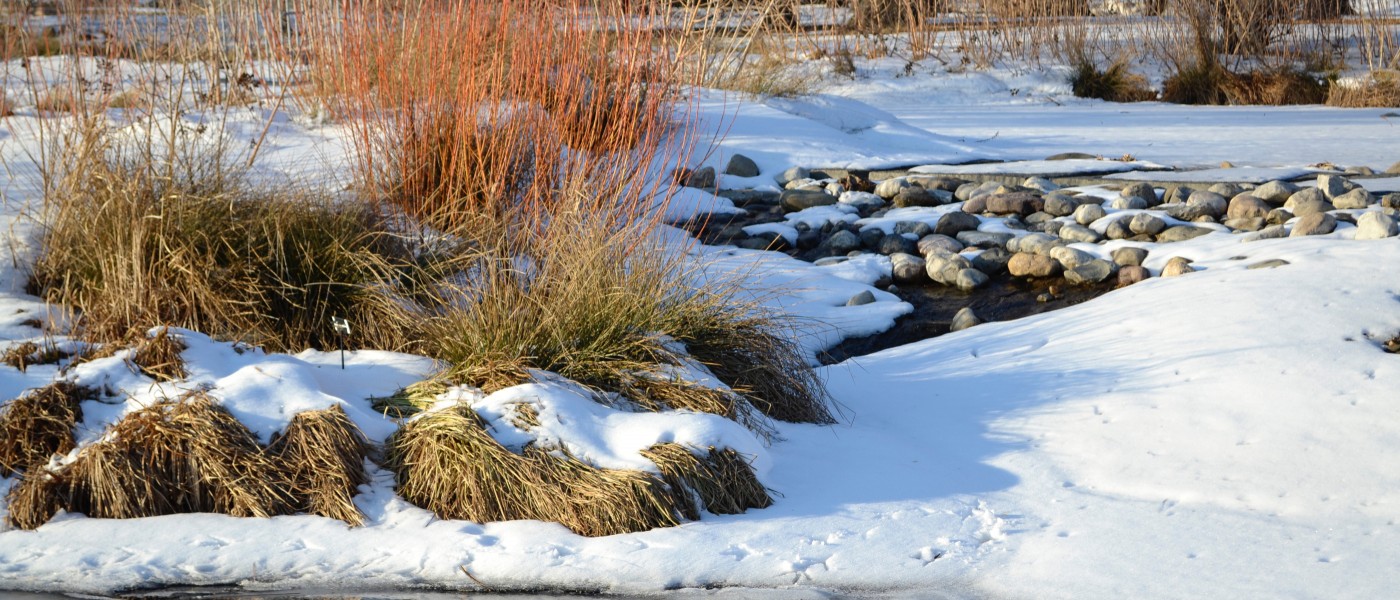Naturalist Brad Klein guides short audio walks through the Shelby White and Leon Levy Water Garden, Japanese Hill-and-Pond Garden, and Osborne Garden. As you walk, listen to descriptions of the habits and survival strategies of wildlife you may encounter in the winter months.
Audio Walks
Track 1: Winter Walk Around the Water Garden
Starting from the boulders at the southeast edge of the pond, you may choose to circle the pond in a clockwise direction while listening to Klein’s stories about the landscape and its winter birds.
Hi, I'm Brad Klein. In this series of audio walks, I'm sharing some of the stories that I might share on a guided nature tour. Welcome to a short winter walk around the Water Garden. Let's start near these large, beautiful stones that provide seating along the southeast side of the pond, but really you can start wherever you wish. I visited in late autumn to record the sounds you're hearing and walked clockwise around the pond. So facing the water, you might trace my footsteps by walking at your own pace to your left. This tour takes five or 10 minutes to walk all the way around the pond. You can pause the audio at any time.
Its full name is the Shelby White and Leon Levy Water Garden. This garden highlights wetland and riparian plants like black tupelo trees, sedges, and rushes. There are signs along the path identifying many of them. In my late October visit, I noticed a large flock of European starlings, you'll hear them in this recording, as well as the songs and calls of grackles, sparrows, and a mockingbird. Brooklyn Botanic Garden is an important stop for many birds migrating south to spend the colder months hundreds of miles from New York City. Winter is in my opinion, the best time to begin birdwatching.
For one thing, there are many fewer species to learn. Over 200 species of bird pass through New York's parks every year, but only a couple of dozen overwinter. And it's a good time to spot old nests in the bare branches of the Garden's trees, not just birds' nests—you might also see a squirrel drey, a nest of leaves where it can sleep and even raise young, and maybe the large paper nest of the bald-faced hornet hanging from a tree limb. Most of those inhabitants won't survive the winter. But a fertile queen hornet will start a new colony in the spring. That's a story for another time.
I've been leading monthly nature walks at BBG since 2012 along with Danielle Gustafson. We've walked around the Garden in all seasons and all temperatures. Each month we explore a nature theme, say dragonflies, or a seasonal theme like plant and animal strategies for winter. But we always watch for whatever bird, insect, or plant catches our interest.
Last year, we had a great bird sighting here at the Water Garden. It was an eastern phoebe, and we spotted it in October, which is not too surprising. It's a common bird. A type of flycatcher seen throughout eastern North America. A little bigger than a tufted titmouse, the phoebe is a dapper bird. It's feathered in shades of black and white with a tail that's almost always wagging. It overwinters in the southern states and into Mexico. So no surprise to see it in October on the small trees at the pond's edge, flying out over the water and taking insects on the wing.
But in November of 2019, we were surprised to see presumably the same bird in the same location. And soon we were coming back between our monthly nature walks just to see if this intrepid bird could possibly remain. When our December walk rolled around for the BBG there he or possibly she was, living on berries, I suppose, perhaps the winterberries growing along the water's edge here. The insects were gone, of course. And when our January walk came, still an eastern phoebe, getting by all through a Brooklyn winter. It's unusual to find a phoebe in winter in Brooklyn, but it's part of nature for a few individuals to make the attempt to expand their range.
The phoebe is what's sometimes called a half-hardy species, adaptable enough to defy expectations. And when most of its fellow phoebes were eating insects in Florida or Texas, this one had a plan: Stay in New York for the winter. Be the first on the nesting grounds when spring arrived, along with early access to the flying insects that make up most of its diet in the spring. Besides noticing the birds that remain in the Garden over winter, you might also look closely to see what plant food may be available to them, even in the colder months. Red and gold winterberries and purple beautyberries remain even after most of the leaves have fallen. And if there is open water on the pond, you never know what may arrive. We've seen several species of duck on the water and occasionally a great blue heron will hunt for fish, insects, and even frogs in the shallow waters. Thanks for taking this nature walk with me, Brad Klein, around the Water Garden. Maybe you saw or noticed something new along the way, and I hope that you return soon to Brooklyn Botanic Garden.
Audio walks for the Japanese Hill-and-Pond Garden and Osborne Garden coming soon, please check back!


